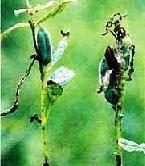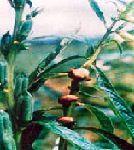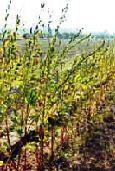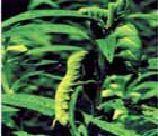Sesame: Insect Pests Management
Sesame: Insect Pests Management
Leaf webber or roller and capsule borer
Biology Egg: Eggs are laid singly on the under surface of leaves, on capsules and branches. Eggs are minute and conical in shape. Freshly laid eggs are white in colour, which later change to dark white before hatching.
Egg: Eggs are laid singly on the under surface of leaves, on capsules and branches. Eggs are minute and conical in shape. Freshly laid eggs are white in colour, which later change to dark white before hatching.- Larva: It is a cylindrical caterpillar, which is referred as the neonate larva just after hatching and passes through five larval instars before going in to pupation. The larva is greenish in colour with black head and about 15 mm in length.
- Pupa: The pupa is slender, long necked and greenish-reddish-brown in colour. A pair of eyes is present on anterior end. The body is light reddish brown, greenish white at first. It changes gradually to pale reddish white, dark reddish, reddish brown and pale whitish later on.
- Adult: The adult is medium sized moth with reddish yellow forewings
- The young larvae roll together a few top leaves and feed them.
- Later, some more leaves are affected.
- In the early stage of infestation, the plant dies without producing any branch or shoot.
- In later stage of attack, infested shoots stop growing.
- At flowering, larvae feed inside the flowers and on capsule formation, larvae bore into capsule and feed on developing seeds.
- Parasitoids: Trichogrmma spp., Bracon hebator, B. brevicornis, Phanerotoma handecasisella, Campoplex sp, Erioborus sp, and Apanteles spp. etc.
- Predators: Eocantheconia furcellata, Cicindella spp., lacewing, ladybird beetle, spiders, red ant etc.
Gall fly
Biology Maggot: The maggot is white to orange in colour, legless and with body tapering exteriorly, grows up to 3 to 4 mm in length. Maggots feed inside the fl oral buds and young capsules leading to formation of galls of up to 6 mm in diameter.
Maggot: The maggot is white to orange in colour, legless and with body tapering exteriorly, grows up to 3 to 4 mm in length. Maggots feed inside the fl oral buds and young capsules leading to formation of galls of up to 6 mm in diameter.- Pupa: Maggot pupates inside the galls.
- Adult: The adult is a 5 mm long red-bodied midge (mosquito-like fly). Female midges lay eggs along the veins of terminal leaves.
- Young larvae are less frequent on pods than on other plant parts. They feed externally by making a loose web, which sticks several leaves together.
- The larvae feed on leaves and young shoots. Excreta (frass) remains between the leaves and the loose web.
- At a later stage, the larvae infest the sesame fruit capsule making an entrance hole on the lateral side and feeding on the seeds inside the capsule; they leave excreta on the seeds.
- Parasitoids: Pteromalus fasciatus etc.
- Predators: Spider, ladybird beetle, lacewing etc.
Leaf hopper
Damage symptoms Both nymphs and adults suck the sap from leaves and transmit phyllody disease.
Both nymphs and adults suck the sap from leaves and transmit phyllody disease.- Curling of leaf edges and leaves turn red or brown.
- The leaves dry up and shed.
Sphinx moth
Biology Egg: Eggs are globular is shape and are laid singly on the under surface of leaves. The egg period is 2-5 days.
Egg: Eggs are globular is shape and are laid singly on the under surface of leaves. The egg period is 2-5 days.- Larva: Larva is stout, green with yellowish oblique stripes and curved anal horn. The larval period lasts for 60 days.
- Pupa: It pupates in earthern cocoon in soil. The pupal period lasts 14-21 days and 7 months in summer and winter, respectively.
- Adult: The adult moth is giant hawk moth, brownish with a characteristic skull marking on the thorax and violet yellow bands on the abdomen. Hind wings yellow with black markings.
- The damage is caused by the larvae which feed voraciously on leaves and defoliate the plants.
- The moth is also harmful as it sucks honey from the honey combs in apiaries.
- Predators: Lacewing, ladybird beetle, reduviid bug, spider, red ant, black drongo (King crow), common mynah, big-eyed bug (Geocoris sp), pentatomid bug (Eocanthecona furcellata), preying mantis etc.
IPM for Sesame
To know the IPM practices for Sesame, click here.
Source: NIPHM and Directorate of Plant Protection, Quarantine & Storage
Last Modified : 2/12/2020
© C–DAC.All content appearing on the vikaspedia portal is through collaborative effort of vikaspedia and its partners.We encourage you to use and share the content in a respectful and fair manner. Please leave all source links intact and adhere to applicable copyright and intellectual property guidelines and laws.
RELATED ITEMS
Sesame: Diseases and Symptoms
This topic covers the Information related to Disea...
Sesame Pests
This topic covers the information related to Pest ...
Sesame: Natural Enemies
Natural enemies of Sesame insect pests are covered...
Seasme - Crop Stage-wise IPM
This topic covers the Information related to Crop ...
